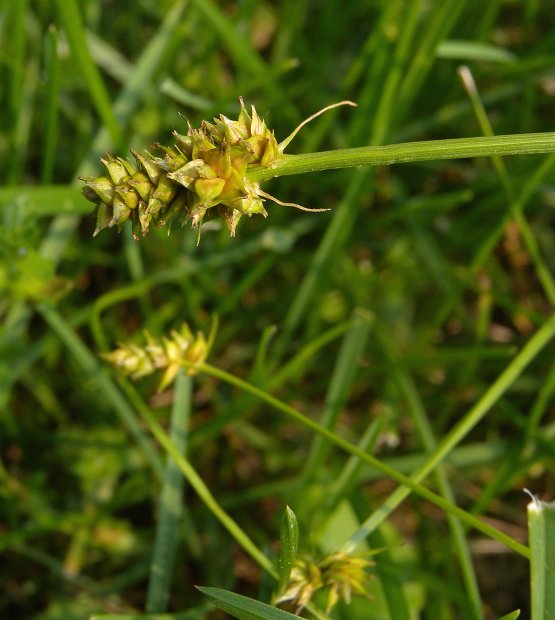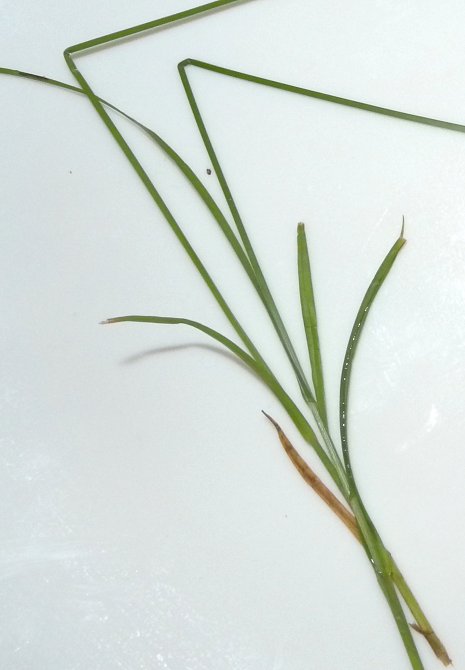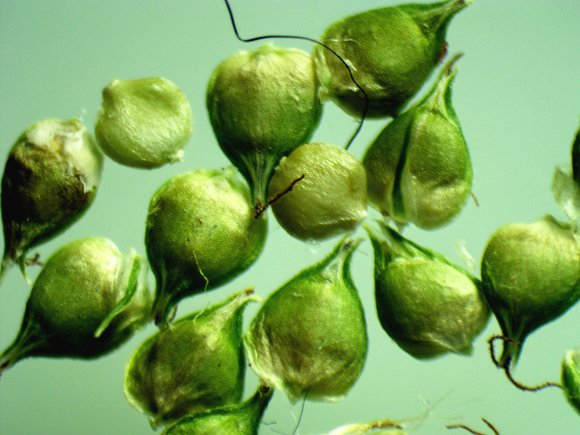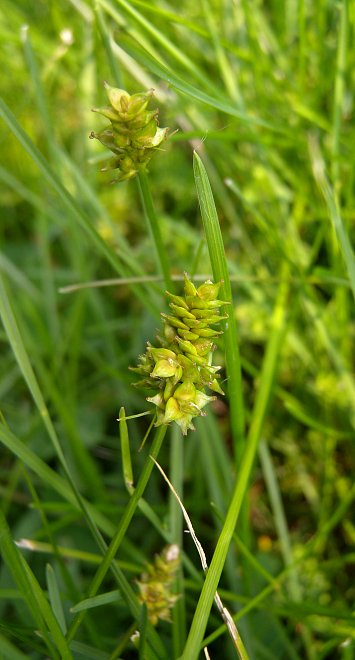Leavenworth's Sedge
Carex leavenworthii
Sedge family (Cyperaceae)
Carex leavenworthii
Sedge family (Cyperaceae)
Description:
This perennial sedge is typically 8–16" long with a leafy culm that is
erect or ascending. This sedge can occur as scattered and solitary
leafy culms, or it may form loose tufts of leafy culms. The culm is
light to medium green, sharply 3-angled, slender, and hairless; there
are about 2 ascending to arching leaves along the lower one-third of
its length (not counting withered remnants of leaves). The base of the
culm and lowermost sheath is brownish. Individual leaf blades are 2–6½"
long and 1–2.5 mm. across; they are medium green, hairless, and flat.
Individual leaf sheaths are membranous along one side and light green
with longitudinal veins along the other two sides; they are rather
tight and hairless. The upper mouth of each sheath is concave and
slightly thickened. Each fertile culm terminates in several dense
clusters of spikelets; this inflorescence is typically 7–12 mm. long
and 5–8 mm. across. It has a spiky appearance because of the short
beaks of the perigynia. At the bottom of the inflorescence (or near its
base) there are 1–2 narrowly linear or filiform (thread-like) leafy
bracts; these bracts are up to 12.5 mm. long. Individual spikelets have
6–21 perigynia that are widely spreading to ascending along their
central axis; staminate (male)
florets occur at the very apex of a spikelet (if they are present at
all), while pistillate (female) florets occur below.

The perigynia of the pistillate florets are about 2.5 mm. long and 2 mm. across; they are plano-convex, rather flattened, and hairless. The body of each perigynium is ovate-orbicular in shape, rather abruptly tapering into a short beak; the base of the perigynium's body can be widely rounded (more common), somewhat truncate (less common), or slightly cordate (less common). In addition, the lateral margins of the perigynium's body are not winged. The slightly convex outer surfaces of the perigynia are not marked by wrinkles, while their flat inner surfaces either lack wrinkles or they are faintly wrinkled. Immature perigynia are whitish green. The pistillate scales are about two-thirds the length of perigynia; they are ovate in shape with acute tips, green-veined in the middle, and membranous along their margins. The blooming period occurs during late spring or early summer for about 1–2 weeks. The florets are cross-pollinated by the wind. Afterwards, the perigynia become golden brown to brown before they become disarticulated from the inflorescence. Mature achenes within the perigynia are about 1.25 mm. long and 1 mm. across; they are flattened-orbicular in shape, although slightly wider below the middle than above. The root system consists of fibrous roots; occasionally rhizomes may develop to produce loose tufts of clonal plants.

Cultivation: The preference is full to partial sun, mesic to dry conditions, and soil containing loam, clay-loam, or rocky material. This sedge adapts to areas where there is open ground or the competing ground vegetation is low. It can survive in lawns where the grass is not cut too low or too often.
Range & Habitat: The native Leavenworth's Sedge (Carex leavenworthii) occurs occasionally throughout Illinois (see Distribution Map). It is found primarily in south-central to mid-central USA in areas along the Mississippi River drainage system. This sedge is also found in scattered areas further east, and in California, where it was accidentally introduced. Habitats include dry upland woodlands, disturbed open woodlands, disturbed areas of upland prairies, prairie swales, savannas, limestone and sandstone glades, areas along sandstone and limestone cliffs, alvars along Lake Michigan (in Wisconsin), roadsides, city parks, and lawns. This sedge can be found in both high quality natural areas and highly disturbed grassy habitats.

Faunal Associations: Various insects feed on upland sedges (Carex spp.) – this includes aphids, leafhoppers, billbugs (Sphenophorus spp.), larvae of leaf-miner flies (Cerodontha spp.), larvae of leaf-miner moths (Elachista spp.), and, in open areas, grasshoppers (see Grasshopper Table). Among vertebrate animals, birds that eat the seeds include upland gamebirds, sparrows, and longspurs, as well as the Northern Cardinal and Slate-colored Junco (see Bird Table). White-tailed Deer and other hoofed mammalian herbivores sometimes browse on the foliage of sedges, although it is not preferred as a source of food.
Photographic Location: A semi-shaded grassy area of Crystal Lake Park in Urbana, Illinois.

Comments: This is a petite sedge with low slender leaves and a small inflorescence, making it easy to overlook. Leavenworth's Sedge can be easily confused with two other similar sedges, specifically Capitate Sedge (Carex cephalophora) and Midland Sedge (Carex mesochorea). Both Capitate Sedge and Leavenworth's Sedge can be found growing in lawns, however Capitate Sedge is more conspicuous when this happens because it is slightly larger in size overall, it has wider leaf blades (typically 2.5–5 mm. across), and it is more likely to form dense tufts of leafy culms. Compared to Leavenworth's Sedge, Midland Sedge is also a larger and more conspicuous sedge with wider leaf blades (typically 2.5–4 mm. across); it also has longer perigynia with more narrowly rounded bottoms and longer beaks, and its pistillate scales have cuspidate (short-pointed) or short-awned tips, rather than acute. Like the preceding two sedges, Midland Sedge is sometimes found in disturbed grassy areas, especially along railroads and roadsides.

The perigynia of the pistillate florets are about 2.5 mm. long and 2 mm. across; they are plano-convex, rather flattened, and hairless. The body of each perigynium is ovate-orbicular in shape, rather abruptly tapering into a short beak; the base of the perigynium's body can be widely rounded (more common), somewhat truncate (less common), or slightly cordate (less common). In addition, the lateral margins of the perigynium's body are not winged. The slightly convex outer surfaces of the perigynia are not marked by wrinkles, while their flat inner surfaces either lack wrinkles or they are faintly wrinkled. Immature perigynia are whitish green. The pistillate scales are about two-thirds the length of perigynia; they are ovate in shape with acute tips, green-veined in the middle, and membranous along their margins. The blooming period occurs during late spring or early summer for about 1–2 weeks. The florets are cross-pollinated by the wind. Afterwards, the perigynia become golden brown to brown before they become disarticulated from the inflorescence. Mature achenes within the perigynia are about 1.25 mm. long and 1 mm. across; they are flattened-orbicular in shape, although slightly wider below the middle than above. The root system consists of fibrous roots; occasionally rhizomes may develop to produce loose tufts of clonal plants.

Cultivation: The preference is full to partial sun, mesic to dry conditions, and soil containing loam, clay-loam, or rocky material. This sedge adapts to areas where there is open ground or the competing ground vegetation is low. It can survive in lawns where the grass is not cut too low or too often.
Range & Habitat: The native Leavenworth's Sedge (Carex leavenworthii) occurs occasionally throughout Illinois (see Distribution Map). It is found primarily in south-central to mid-central USA in areas along the Mississippi River drainage system. This sedge is also found in scattered areas further east, and in California, where it was accidentally introduced. Habitats include dry upland woodlands, disturbed open woodlands, disturbed areas of upland prairies, prairie swales, savannas, limestone and sandstone glades, areas along sandstone and limestone cliffs, alvars along Lake Michigan (in Wisconsin), roadsides, city parks, and lawns. This sedge can be found in both high quality natural areas and highly disturbed grassy habitats.

Faunal Associations: Various insects feed on upland sedges (Carex spp.) – this includes aphids, leafhoppers, billbugs (Sphenophorus spp.), larvae of leaf-miner flies (Cerodontha spp.), larvae of leaf-miner moths (Elachista spp.), and, in open areas, grasshoppers (see Grasshopper Table). Among vertebrate animals, birds that eat the seeds include upland gamebirds, sparrows, and longspurs, as well as the Northern Cardinal and Slate-colored Junco (see Bird Table). White-tailed Deer and other hoofed mammalian herbivores sometimes browse on the foliage of sedges, although it is not preferred as a source of food.
Photographic Location: A semi-shaded grassy area of Crystal Lake Park in Urbana, Illinois.

Comments: This is a petite sedge with low slender leaves and a small inflorescence, making it easy to overlook. Leavenworth's Sedge can be easily confused with two other similar sedges, specifically Capitate Sedge (Carex cephalophora) and Midland Sedge (Carex mesochorea). Both Capitate Sedge and Leavenworth's Sedge can be found growing in lawns, however Capitate Sedge is more conspicuous when this happens because it is slightly larger in size overall, it has wider leaf blades (typically 2.5–5 mm. across), and it is more likely to form dense tufts of leafy culms. Compared to Leavenworth's Sedge, Midland Sedge is also a larger and more conspicuous sedge with wider leaf blades (typically 2.5–4 mm. across); it also has longer perigynia with more narrowly rounded bottoms and longer beaks, and its pistillate scales have cuspidate (short-pointed) or short-awned tips, rather than acute. Like the preceding two sedges, Midland Sedge is sometimes found in disturbed grassy areas, especially along railroads and roadsides.